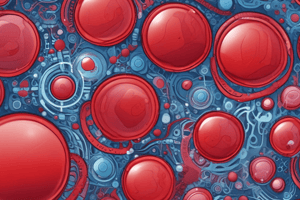Podcast
Questions and Answers
What is the purpose of the Kleihaur-Betke stain?
What is the purpose of the Kleihaur-Betke stain?
- To denature the cytoplasm of the cell
- To identify parasitic worms
- To calculate the size of a transplacental haemorrhage (correct)
- To assess iron stores in bone marrow
What is the purpose of the Perls Prussian Blue stain?
What is the purpose of the Perls Prussian Blue stain?
- To identify targets for further stains
- To assess iron stores in bone marrow (correct)
- To visualize slides in 3D
- To measure disease and monitor patients
What is the purpose of Field stain?
What is the purpose of Field stain?
- To identify parasitic worms
- To provide a red and blue stain
- To denature the cytoplasm of the cell (correct)
- To assess iron stores in bone marrow
What is the purpose of conventional Epi-Fluorescence Microscopy?
What is the purpose of conventional Epi-Fluorescence Microscopy?
What is the purpose of electron microscopy?
What is the purpose of electron microscopy?
What is the purpose of the Coulter Principle?
What is the purpose of the Coulter Principle?
What is the purpose of Flow Cytometry?
What is the purpose of Flow Cytometry?
Flashcards are hidden until you start studying
Study Notes
Methodologies in Haematology: Stains, Microscopy, and Quality Management
- Romanowski stain is commonly used in haematology for most work, providing a red and blue stain to identify targets for further stains.
- Kleihaur-Betke stain is used to calculate the relative size of a transplacental haemorrhage, assessing the survival rate of the haemorrhage.
- Perls Prussian Blue stain is an iron stain used to assess iron stores in bone marrow and ferritin levels in patients.
- Field stain is an acidified version of the Romanowski stain and is used to denature the cytoplasm of the cell slightly, often used to identify malaria.
- Giemsa stain is used to identify parasitic worms and high eosinophil concentration, and can determine the type of worm through counting dots.
- Conventional Epi-Fluorescence Microscopy is used for confirmatory tests, such as diagnosing chronic myeloid leukaemia.
- Electron microscopy is used for treatment-related identification and to show fine morphological operations in leukaemia cells more clearly.
- Confocal microscopy is used to visualize slides in 3D, showing how platelets work based on anatomy.
- Haemocytometer is used to measure WBC and RBC counts, but can be fiddly and inaccurate.
- Coulter Principle is a highly accurate method for counting and sizing RBCs based on the electrical charge across a gate.
- Flow Cytometry is used to measure disease and monitor patients, such as HIV patients, to ensure medications are working and they are not becoming immunocompromised.
- Quality management and control are critical in haematology to maintain consistent standards and prevent errors that could lead to misdiagnosis and mistreatment. ISO 15189 is a standard used for quality management in haematology labs.
Studying That Suits You
Use AI to generate personalized quizzes and flashcards to suit your learning preferences.




